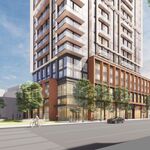agoraflaneur
Active Member
I don't know if there is a thread for this project, so if there is already, apologies.
Roncesvalles was finally finished this summer, but under the radar the western portion of Dundas Street downtown (Bathurst to Lansdowne) was also undergoing renovations. They aren't totally finished yet, but a few weeks ago, to my astonishment and delight, I found a series of excellent parkettes placed along the south side of Dundas west, basically from Ossington to Lansdowne. They consist of some brickwork, various plantings, some surprisingly wonderful metal, wood and concrete benches in addition to funky new postindustrial rusted bike locks. The sidewalks have also been redone, while new plantings of trees will be done next spring. Very stoked on this work. Kudos to the city.
Roncesvalles was finally finished this summer, but under the radar the western portion of Dundas Street downtown (Bathurst to Lansdowne) was also undergoing renovations. They aren't totally finished yet, but a few weeks ago, to my astonishment and delight, I found a series of excellent parkettes placed along the south side of Dundas west, basically from Ossington to Lansdowne. They consist of some brickwork, various plantings, some surprisingly wonderful metal, wood and concrete benches in addition to funky new postindustrial rusted bike locks. The sidewalks have also been redone, while new plantings of trees will be done next spring. Very stoked on this work. Kudos to the city.
Attachments
Last edited:












